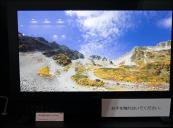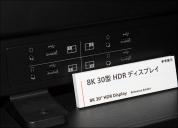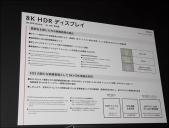
-
IMDB reports Star Wars VII have scenes done with 35mm film and it looks good in the bbbiiiggg screen,
If it had been shot on modern digital camera it'll look even better. Idea to using film was part marketing and part political decision (to save Kodak).
-
G7 and GH4 are enough cameras to do an IMAX release film, you just need to know how to do it...
-
At this year’s Consumer Electronics Show (CES) in Las Vegas, NV January 6-9, Canon U.S.A., Inc., a leader in digital imaging solutions, will challenge attendees to see the impossible at booth #13106 in the Central Hall. Canon’s booth will feature a Canon 8K Ride Experience where attendees can see the future of visual imaging and experience, firsthand, the physical and emotional reactions that take place when an 8K video projected on a large screen simulates a physical journey. There will also be an 8K Photo Gallery that displays precise moments from an 8K video. The Canon booth itself will be composed of three environments simulating a home, an office, and a professional studio. Within each zone Canon will offer hands-on demonstrations of current real-world imaging solutions for attendees to experience themselves.
“We believe there really is only one way for our valued customers and users to truly understand and embody Canon See Impossible and that is through seeing and experiencing real life examples of how Canon digital imaging solutions can impact their daily lives on both a professional and personal level,” said Yuichi Ishizuka, president and COO, Canon U.S.A., Inc. “We are excited for attendees to experience these solutions at our CES 2016 booth as well as have them enjoy the unique Canon 8K Ride Experience, which will be new to most attendees.”
Introduced at Canon EXPO, held this past September in NYC, this 8K Ride Experience projects 8K video on large screens surrounding viewers to give them a unique sense of movement while sitting or standing still. By experiencing imagery from all angles, the technology can simulate a physical journey often sparking a physical or emotional reaction.
-
The granular details of a church exterior in one scene drew audible gasps from a few of the dozen or so audience members able to fit into the screening room. But the overall experience was rather lackluster.
http://www.theverge.com/2016/1/7/10725492/i-was-taken-for-a-ride-by-canon-s-8k-experience
-
Panasonic Corporation today announced that it has developed single cable and connector solution that enable the transmission of uncompressed full-spec 8K video signals.*1
Currently, to transmit video signal via connector-equipped cables from an 8K signal source or other devices to an 8K display, 4K-equivalent images are transmitted using four HDMI cables, and are then combined to show in 8K resolution by using image processing. Panasonic’s newly-developed connector-equipped cable, which uses plastic optical fiber technology, can achieve the transmission full-spec 8K video via a single cable, with improved bandwidth and length.
http://shop.panasonic.com/about-us-latest-news-press-releases/ces2016-8k-video.html
-
Brookman Technology, Inc. has commenced the delivery of engineering samples of image sensor BT3300N for 8K Super Hi-Vision broadcast, which was co-developed with NHK (Japan Broadcasting Corporation) and Professor Kawahito’s Group of Shizuoka University. Brookman Technology, Inc. starts its production and delivery under the agreement with NHK.
8K Super Hi-Vision is set to begin test broadcasting in 2016 and roll out full broadcasting by 2018. The image consists of 33Mpixels (7680 x 4320), and is 16 times larger than the current HDTV.
-
I don't know who is right and who is wrong: the industry that launches all the new technologies faster the market can take any notice of it, or the folks that still distrust anything but a DVD?
-
or the folks that still distrust anything but a DVD?
It is same industry that offer this folks DVDs, as it is very profitable business :-)
8K will have very big problem due to progress stall in semiconductors.
TV industry on their side is pretty ready for 8K, they just do not want to tell you that actual visible advantages require you to have 85" TV as absolute minimum size, preferable to give TV all your big wall .
-
85" if you're sitting really close, maybe. At a distance of 10-12 feet or so, 85" is close to the minimum size to perceive 4K resolution.
-
At the China Information Technology Expo (CITE) 2016 in Shenzhen, southern China, during April 8-10, China-based TFT-LCD panel makers focused on exhibiting Ultra HD TV panels, including BOE Technology's 98-inch 7680 by 4320 (8kx4k) model and 82-inch 10240 by 4320 (10kx4k).
-
I wonder whether those display guys ever bother to discuss where >= 8k video material would come from.
Just look how today the vast majority of even A-Movies are produced in 2k. And when you look at the results, only very few of those 2k movies bother to be shot and focused such that this resolution is actually utilized.
Ok, there will be some push towards 4k shooting/post-production now that 4k TVs are more common, but you can bet that the ratio of movies actually being focused such that 4k resolution is utilized will be even smaller than the ratio of fully-2k-utilizing productions today.
I think it will be at least 10 years until we'll see significant amounts of material actually exploiting 4k resolution to its fullest. And I doubt that aside from a few sports live events under bright sunlight we'll see 8k productions actually using 8k resolution in the next 20 years, maybe not even after that.
-
I wonder whether those display guys ever bother to discuss where >= 8k video material would come from.
You can even today make 8K movie as timelapse.
You can also make it using 4 synchronized 4K cameras and software processing to improve resolution.
-
Sure, but the demand for timelapse videos is pretty limited, and working with 4 synchronized cameras is lots of effort for little return. Just look how few stereoscopic movie productions bother two use 2 cams, but only apply digital 3d effects in postproduction.
It's like with all those "more than 5.1 channel" audio formats: A few examples are produced "because it can be done and draws attention while it's new", and then daily routine production goes on barely utilizing 5.1 to its possibilities - because it's just more work for marginal additional profits.
-
Sure, but the demand for timelapse videos is pretty limited, and working with 4 synchronized cameras is lots of effort for little return.
I do not see anything hard, as for you can cut perfectly in 4K and later just use batch mode to improve resolutions using 3 other streams.
Just look how few stereoscopic movie productions bother two use 2 cams, but only apply digital 3d effects in postproduction.
Not so few, specialized resources exist for this. Most of attraction to make 3d at postproduction come from producers and crews who are unable and do not want to learn to shoot in 3d. Hiring cheap stuff to do it in post saves money.
A few examples are produced "because it can be done and draws attention while it's new", and then daily routine production goes on barely utilizing 5.1 to its possibilities - because it's just more work for marginal additional profits.
This part is false, Atomos audio will be almost standard in upcoming titles. In theaters it is already almost all films that come with more than 5.1 sound.
-
Including a sound track endoded in a format that is capable of more than 5.1 is the cheap/easy part, the expensive/hard part is to produce a sound track that makes any significant use of the additional possibilities.
If you let people enter a movie theater after the trailers/intros showcasing the sound system are over, chances are they won't be able to tell the difference between a plain old Dolby Digital 5.1 soundtrack, some 7.1 soundtrack or some Atmos soundtrack - not because it would be technically impossible to produce distinguishable soundtracks, but because most movies just don't make use of the possibilities. And I bet is will continue to be like this.
-
If you let people enter a movie theater after the trailers/intros showcasing the sound system are over, chances are they won't be able to tell the difference between a plain old Dolby Digital 5.1 soundtrack, some 7.1 soundtrack or some Atmos soundtrack - not because it would be technically impossible to produce distinguishable soundtracks, but because most movies just don't make use of the possibilities.
Atomos is not so hard to spot during specific scenes.
For movie producers 5.1 and 7.1 or 7.2 does not make much real difference as sources are placed in space and it is just software setting on processing and encoding stage. So, your statement sound strange.
It is clear that all will go to the Atomos path with separate object streams.
-
Japan's public broadcaster NHK has begun the world's first regular TV satellite broadcasts in 8K resolution. The "Super Hi-Vision" test channel launched on Monday and has a mix of content in both 4K and 8K resolution, which at 7680 x 4320 pixels is four times as sharp as 4K and 16 times as sharp as 1080p; the spec also allows for 22.2-channel audio.
-
Panasonic and Sony will partner with broadcaster NHK and others to develop technology for televisions capable of handling ultrahigh-resolution 8K video, building an all-Japanese alliance to reclaim market share lost to foreign rivals.
http://asia.nikkei.com/Business/Companies/Lost-market-share-prompts-Sony-Panasonic-TV-tech-alliance
-

 sample816.jpg794 x 588 - 82K
sample816.jpg794 x 588 - 82K
 sample817.jpg782 x 562 - 41K
sample817.jpg782 x 562 - 41K
 sample818.jpg772 x 584 - 60K
sample818.jpg772 x 584 - 60K -
Strange Youtube decisions concerning 8K
Here’s what’s strange: it lists the codec as AVC, otherwise known as H.264. The problem with that is the largest frame size permitted by the H.264 video codec standard is 4,096 x 2,304, and yet somehow this video has a resolution of 7,680 x 4,320. Which means that either this video, or the video standard must be lying.
Well, not exactly. The frame resolution is Full Ultra High Definition (FUHD - 7,680 x 4,320), and the video codec is H.264 / AVC. It’s just a non-standard H.264 / AVC.
http://www.mysterybox.us/blog/2017/2/21/delivering-8k-using-avch264
Decision is stupid, as 8K H.264 is not accelerated and 49Mbit is low bitrate.
In same time H,265 8K is fully hardware decoded by 1000x Nvidia cards. -
Last I checked neither Vimeo or YouTube accept H265. Hope this changes soon. Will allow much faster 1080p uploads!
-
For faster uploads you need good channel first :-)
I upload all exhibitions videos now at 4K 70Mbit, 10 minute one takes around 7-8 minutes to upload.
-
For clients I upload 1 hour long videos sometimes. So it takes time for me. :-( H265 would half that time with same quality. Or do we all have to wait for the new format without expensive patent?
Strangely Panasonic GH5 already records Photo video mode in H265, so apparently that should be GTG for new 'summer' update.
Howdy, Stranger!
It looks like you're new here. If you want to get involved, click one of these buttons!
Categories
- Topics List23,993
- Blog5,725
- General and News1,354
- Hacks and Patches1,153
- ↳ Top Settings33
- ↳ Beginners256
- ↳ Archives402
- ↳ Hacks News and Development56
- Cameras2,368
- ↳ Panasonic995
- ↳ Canon118
- ↳ Sony156
- ↳ Nikon96
- ↳ Pentax and Samsung70
- ↳ Olympus and Fujifilm102
- ↳ Compacts and Camcorders300
- ↳ Smartphones for video97
- ↳ Pro Video Cameras191
- ↳ BlackMagic and other raw cameras116
- Skill1,960
- ↳ Business and distribution66
- ↳ Preparation, scripts and legal38
- ↳ Art149
- ↳ Import, Convert, Exporting291
- ↳ Editors191
- ↳ Effects and stunts115
- ↳ Color grading197
- ↳ Sound and Music280
- ↳ Lighting96
- ↳ Software and storage tips266
- Gear5,420
- ↳ Filters, Adapters, Matte boxes344
- ↳ Lenses1,582
- ↳ Follow focus and gears93
- ↳ Sound499
- ↳ Lighting gear314
- ↳ Camera movement230
- ↳ Gimbals and copters302
- ↳ Rigs and related stuff273
- ↳ Power solutions83
- ↳ Monitors and viewfinders340
- ↳ Tripods and fluid heads139
- ↳ Storage286
- ↳ Computers and studio gear560
- ↳ VR and 3D248
- Showcase1,859
- Marketplace2,834
- Offtopic1,320












